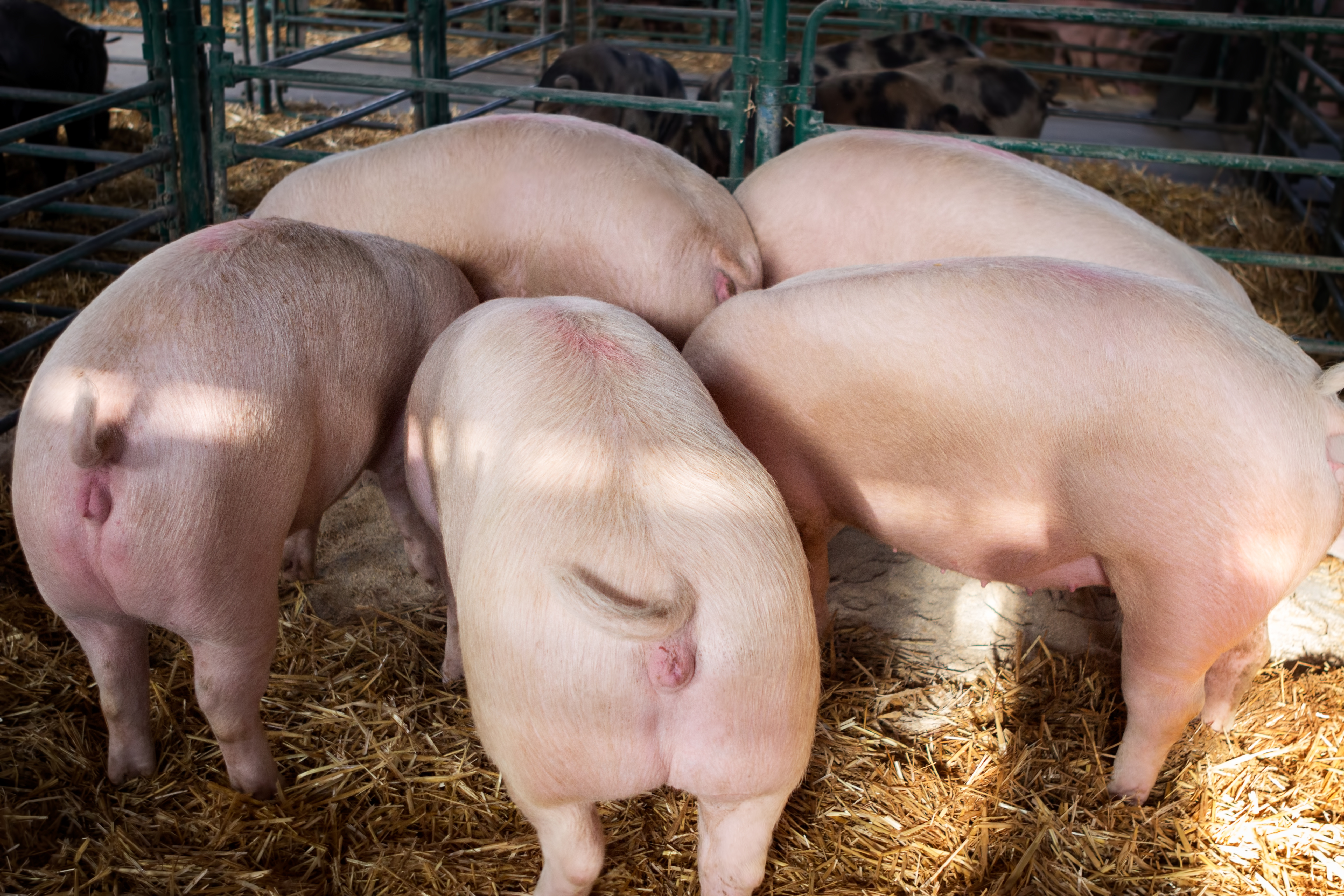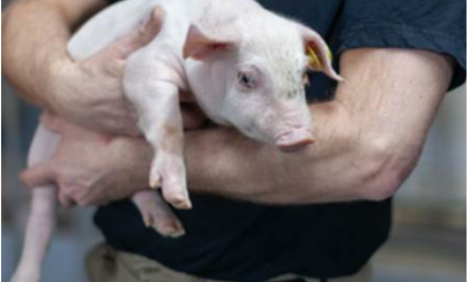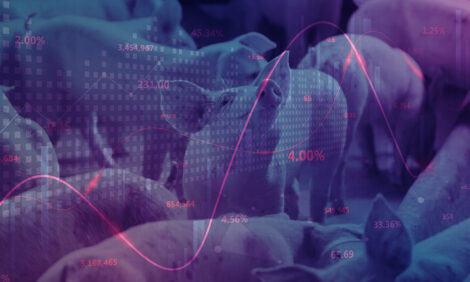



Is your feeding system the best option for your sows?
Do you floor-feed? Do you use individual feeding stalls? And what exactly are the welfare implications of adopting different feeding systems?It is common for gestating sows to be fed a diet that is unlikely to result in satiation. Thus, access to food is of particular importance to gestating sows, and most of the aggression observed between group-housed sows following the establishment of the hierarchy occurs around feeding (Baxter, 1983). As will be discussed, the type of system utilised to feed gestating sows affects competition for feed, and consequently the level of sow aggression associated with feeding.
Simultaneous feeding systems
Floor/trough feeding
The low costs associated with the implementation and management of floor-feeding systems (ie, when food is dropped directly onto the pen floor) make them an attractive option for some pig farmers. Aggression in floor-feeding systems peaks immediately following the delivery of food and continues until most of the food is consumed (eg Csermely and Wood-Gush, 1987), which can be in as little as 5 to 10 minutes (Verdon et al., 2018). Dominant sows monopolise the feeding area as long as feed remains present (Verdon et al., 2018). This forces low-ranking sows to either risk receiving aggression by feeding near high-ranking sows, or avoid the area where feed is available. Consequently, low-ranking sows have reduced feed intake and exhibit lower weight gain in floor-feeding systems (Edwards, 1992; Verdon et al., 2016).
Feeding sows multiple times per day can reduce feeding motivation (Jensen et al., 2012) and aggression delivered around floor-feeding (Verdon et al., 2015b), but does not create more opportunities for submissive sows to feed (Verdon et al., 2018). The welfare of sows in floor-feeding systems may be improved through a generous space allowance, by maximising the spread of feed onto the floor (ie, increasing the number of feed hoppers), and by setting feed allowances on the requirements of the thinnest sow in the group.

Feeding stalls
Feeding sows from a trough with individual feeding positions separated by partial (shoulder) or full (body) length barriers, with or without a ‘locking’ in mechanism, provide some protection from aggression while still enabling simultaneous feeding. In comparison to floor-feeding systems, there is less aggression around feeding between gilts that are fed in stalls (Barnett et al., 1992; Barnett et al., 1997; Andersen et al., 1999). However, gaining access to the feeding stalls can lead to competition and aggression (Bench et al., 2013), and if there is no locking gate faster eating sows (that are more likely to be the older, larger animals in the group; Bøe and Cronin, 2015) can displace slower eating sows from their stalls resulting in an increased occurrence of vulva bites (Andersen et al., 1999). Trickle feeding (dispensing small amounts of feed at a time) may reduce stall displacements by keeping sows in their individual feeding positions (Chapinal et al., 2010).
Sequential feeding systems
Electronic sow feeder
The electronic sow feeder (ESF) is the most technical feeding option for group-housed sows and thus requires training of sows and staff in use of the system as well as regular maintenance checks. Upon entry to the ESF a backing gate closes, confining the individual sow to the feeding station. The confined sow is identified via a transponder located in their ear-tag and a computer-controlled feeder delivers her individualised diet. When the sow exits the ESF the backing gate is opened so the next sow can enter.
Benefits of the ESF include offering the most protection to sows while they are feeding, allowing for the most individualised delivery of feed, provision of a computerised record of sow feed intake and generally being suitable for large, dynamic groups of sows (approx. 40-60 sows per ESF). Forcing sows to feed in sequence, however, can result in aggression and the displacement of subordinates as sows queue at the entrance of the ESF (Bench et al., 2013). The design of the pen and the placement of the ESF is essential to preventing queuing and aggression in ESF systems. Keeping the number of sows per ESF as low as possible, ensuring an un-impeded, one-way and relatively long exit from the ESF and positioning the ESF away from busy areas or other resources (eg drinker, hay rack), are required to improve accessibility for subordinate sows (reviewed in Verdon et al., 2015a).
Hunger in the gestating sow
It is likely that the quantitative dietary restrictions imposed on gestating sows means that all sows experience feelings of hunger and are highly motivated to feed. As discussed by Verdon et al. (2018), when sows must compete for access to feed the motivation to minimise harm by avoiding aggression (ie, fear) is in direct conflict with the motivation to approach the feeding area. Thus, the level of fear within the cohort of sows that avoid the feeding area or feeder needs recognition.
Reducing sow hunger could reduce competition for feed, and consequently aggression around feeding (D’Eath et al., 2018). Increasing the quantity of feed has been more effective at reducing feeding motivation in sows than the inclusion of fibre in the diet (Jensen et al., 2012; Jensen et al., 2015), while extending the time taken for sows to consume their daily ration can reduce general activity (Bergeron and Gonyou, 1997), but may cause crowding and contribute to increased aggression in an ESF system (Bench et al., 2013).
Conclusions
Hunger is one of the most basic, primitive and unremitting of all emotions (Webster, 1995). Regardless of the feeding system, it is essential that all group-housed sows can access the feeding area and feed with minimal risk to their welfare. This requires careful consideration of pen design, particularly around the feeding area, combined with continued efforts to improve sow satiety.
| References | ||||
|---|---|---|---|---|
| Andersen, I.L., Bøe, K.E., Kristiansen, A.L. | ||||
| (1999) | The influence of different feeding arrangements and food type on competition at feeding in pregnant sows.. Applied Animal Behaviour Science | 65: 91-104 | ||
| Barnett, J., Bottcher, R., Hoff, S. | ||||
| (1997) | Modifying the design of group pens with individual feeding places affects the welfare of pigs.. Fifth international livestock environment symposium | 965-971 | ||
| Barnett, J., Hemsworth, P., Cronin, G., Newman, E., McCallum, T., Chilton, D. | ||||
| (1992) | Effects of pen size, partial stalls and method of feeding on welfare-related behavioural and physiological responses of group-housed pigs.. Applied Animal Behaviour Science | 34: 207-220 | ||
| Baxter, M. | ||||
| (1983) | Feeding and aggression in pigs.. Applied Animal Ethology | 11:74-75 | ||
| Bench, C., Rioja-Lang, F., Hayne, S., Gonyou, H. | ||||
| (2013) | Group gestation housing with individual feeding I: How feeding regime, resource allocation, and genetic factors affect sow welfare.. Livestock Science | 152:208-217 | ||
| Bergeron, R., Gonyou, H.W. | ||||
| (1997) | Effects of increasing energy intake and foraging behaviours on the development of stereotypies in pregnant sows.. Applied Animal Behaviour Science | 53: 259-270 | ||
| Bøe, K., Cronin, G. | ||||
| (2015) | Individual variation in eating speed of dry sows.. Journal of Animal Science | 93: 1881-1886 | ||
| Chapinal, N., Ruiz-De-La-Torre, J.L., Cerisuelo, A., Gasa, J., Baucells, M.D., Manteca, X. | ||||
| (2010) | Aggressive behaviour in two different group-housing systems for pregnant sows.. Journal of Applied Animal Welfare Science | 13: 137-153 | ||
| Csermely, D., Wood-Gush, D.G.M. | ||||
| (1987) | Aggressive behaviour of grouped sows in different contexts.. Applied Animal Behaviour Science | 17:368-369 | ||
| D’Eath, R.B., Jarvis, S., Baxter, E.M., Houdijk, J. | ||||
| (2018) | Mitigating hunger in pregnant sows.. Advances in Pig Welfare. Woodhead Publishing | 199-234 | Duxford, UK | |
| Edwards, SA. | ||||
| (1992) | Scientific perspectives on loose housing systems for dry sows.. Pig Veterinary Journal | 28: 40-51 | ||
| Jensen, M.B., Pedersen, L.J., Theil, P.K., Knudsen, K.E.B. | ||||
| (2015) | Hunger in pregnant sows: Effects of a fibrous diet and free access to straw.. Applied Animal Behaviour Science | 171: 81-87 | ||
| Jensen, M.B., Pedersen, L.J., Theil, P.K., Yde, C.C., Bach Knudsen, K. | ||||
| (2012) | Feeding motivation and plasma metabolites in pregnant sows fed diets rich in dietary fiber either once or twice daily.. Journal of Animal Science | 90: 1910-1919 | ||
| Verdon, M., Hansen, C.F., Rault, J.L., Jongman, L.U., Hansen, L.U., Plush, K., Hemsworth, P.H. | ||||
| (2015a) | Effects of group housing on sow welfare: a review.. Journal of Animal Science | 93: 1999-2017 | ||
| Verdon, M., Morrison, R., Hemsworth, P. | ||||
| (2015b) | Short and long-term repeatability of individual sow aggressiveness.. Animal Production Science | 55: 1512 | ||
| Verdon, M., Morrison, R., Rice, M., Hemsworth, P. | ||||
| (2016) | Individual variation in sow aggressive behavior and its relationship with sow welfare.. Journal of Animal Science | 94: 1203-1214 | ||
| Verdon, M., Zegarra, N., Achayra, R., Hemsworth, P.H. | ||||
| (2018) | Floor feeding sows their daily allocation over multiple drops per day does not result in more equitable feeding opportunities in later drops.. Animals | 8: 1-12 | ||
| Verdon, M.J., Rault, J.L. | ||||
| (2018) | Aggression in group housed sows and fattening pigs.. Advances in pig welfare. Elsevier | 235-260 | United Kingdom | |
| Webster, A.J.F. | ||||
| (1995) | Animal welfare: a cool eye towards eden.. Blackwell Science | Oxford, UK |









